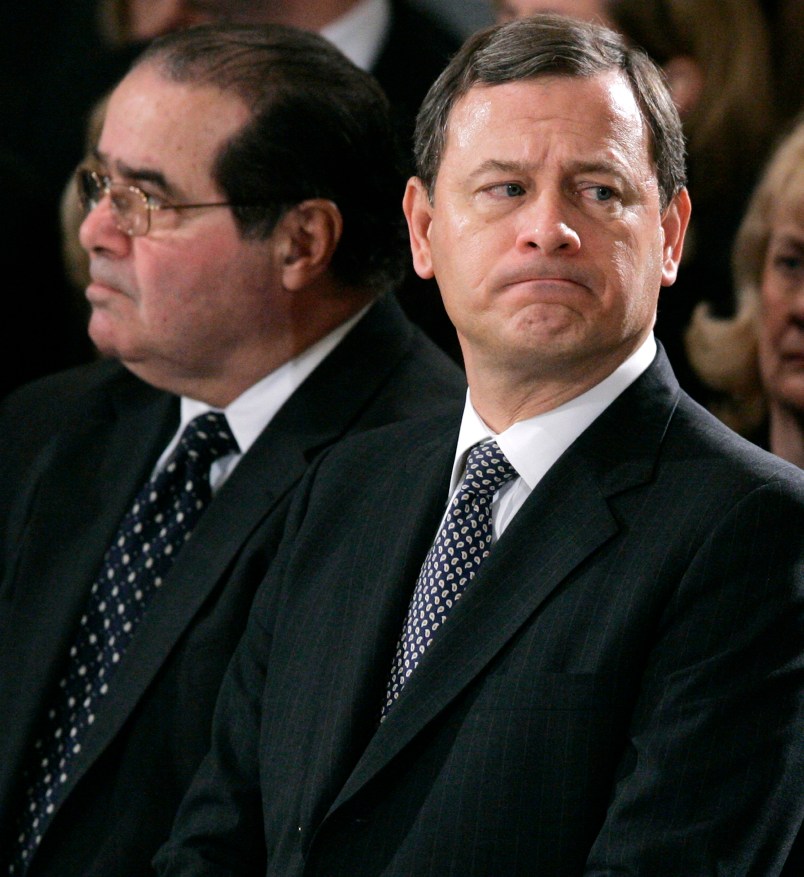Chief Justice John Roberts may be feeling a flash of déjà vu.
For the second time in three years, the Supreme Court has agreed to hear a case aimed at toppling Obamacare. Roberts again finds himself caught between the wishes of a movement that made him America’s most powerful judge, and the reputation of his institution which is being asked to cripple a sitting president’s signature law for the first time in nearly 80 years.
The big question on the minds of conservative legal advocates is: can Roberts bring himself to crush Obamacare this time after he dashed their hopes in 2012?
“He’s under the same pressure that he was under in 2012, where his natural allies really want him to gut the statute and be done with it. And as you saw when he voted to sustain Obamacare, the right came fairly close to accusing him of treason,” said Lucas A. Powe, a Supreme Court historian and law professor at the University of Texas, Austin. “The belief is that if conservatives come to a conclusion, then their justices must have the identical conclusion.”
John Yoo, a former Bush administration lawyer, wrote in the conservative magazine National Review that the case gives Roberts an “opportunity to atone for his judicial sin of two years ago” — choice language to direct at a devout Catholic. “Not many judges have the chance to make up for the mistakes of the past.”
Unlike the 2012 case, King v. Burwell doesn’t present any constitutional questions, nor is there a split in the lower courts that necessitated a resolution by the Supreme Court. The case is simply about how the Affordable Care Act statute ought to be interpreted — whether the IRS erred when permitting premium tax credits to be utilized on the federally-run insurance exchange, which today serves 7 million Americans in 36 states. A defeat for the White House stands to gravely damage the architecture of Obamacare, making insurance unaffordable for many.
“The institutional interests of the Court are stronger at this point [than in 2012] because the law is now in place and providing health coverage for millions of Americans who didn’t have it when the first challenge was heard,” said Doug Kendall, the president of the Constitutional Accountability Center, a progressive group helping with the legal defense of Obamacare. “If Chief Justice Roberts wanted to strike down this law he would have been smarter to do it before it went into effect than he would be in 2015.”
The political atmospherics of the new Obamacare case are hard to ignore. Michael Carvin, the lead attorney arguing against Obamacare, correctly predicted Supreme Court action back in late September, telling TPM: “I don’t know that four justices, who are needed to [take the case] here, are going to give much of a damn about what a bunch of Obama appointees on the D.C. Circuit think. This is a hugely important case.”

Supreme Court Chief Justice John Roberts greets President Barack Obama on Capitol Hill in Washington, Tuesday, Jan. 24, 2012, prior to the president’s State of the Union address. (AP Photo/J. Scott Applewhite)
Asked if he believes he would ultimately lose the votes of any the five Republican-appointed justices, Carvin said, “Oh, I don’t think so.”
The conservative challengers point to a poorly worded section of Obamacare which they argue prohibits the provision of insurance tax credits to residents of the 36 states which didn’t build their own exchange and turned the task over to the federal government. Obamacare architects, meanwhile, have stressed that they intended for the subsidies to be available to Americans in every state, and argue that the law as a whole backs up that case.
There’s little doubt among legal experts that the real-life impacts of the case will play a role with Roberts, who is widely known to be protective of the Supreme Court’s reputation.
“I think that the consequences of [judges’] decisions factor into most of their thinking to some extent. No one lives in a box. They all live in the real world and they’re all attentive to some extent, as any human being would be, to the consequences of their decisions,” said Brian Fitzpatrick, a law professor at Vanderbilt University and former clerk to Justice Antonin Scalia.
Legal scholars say the decision in King is likely to come down to Roberts and potentially Justice Anthony Kennedy, who have more ambiguous views of statutory construction than the seven other members. “The four liberals are wired in, and [Justices Antonin] Scalia and [Clarence] Thomas are wired in, and I assume [Samuel] Alito will vote with the conservatives,” Powe said. “Roberts and Kennedy are up for grabs.”
Both sides are jockeying. Conservative legal scholars claim judicial restraint means letting the law go forward without the subsidies, and leave it to Congress to sort it out. Progressive lawyers say it’s the height of judicial activism for the Supreme Court to preempt a pending December hearing at the D.C. Circuit court by taking the case. (The hearing was canceled as a result.)
“He’s got that bullshit line in Shelby County v. Holder: Congress can fix this. Obviously Roberts knows Congress isn’t going to fix it,” Powe said. “In this case he can easily say again, oh, Congress is gonna fix it. He knows it won’t.”
The Supreme Court is expected to hear oral arguments in King v. Burwell early in 2015 with a probable decision be the end of June.
In the 2012 case, Kennedy was among four justices who voted to wipe out Obamacare in its entirety. Roberts issued a response to conservatives hoping the Court would overturn the law, writing in his 5-4 majority opinion, “It is not our job to protect the people from the consequences of their political choices.”











I think “crushing” the ACA would be the worst thing the right could do to themselves. For one thing, the ACA was created by the Heritage foundation, so it’s not exactly a liberal idea. Also, It would guarantee a massive turnout of progressives in 2016 and it’s going to be a bad enough year for them to begin with.
Can anyone link me a copy of the Republican’s health care plan they plan to use if the ACA is overturned? Surely they have a plan besides “No!,” don’t they?
I think there’s a very good chance they’ll kill the law. And Roberts, in his majority opinion, will snidely note that Congress could pass a simple technical fix bill to change the outcome of the ruling.
I do love the rich irony of a court that has been known to change its written opinions ex post facto (looking at you, Fat Tony) deciding this issue of a missing word or letter.
I agree. However, I think they’ll punt this time not because they’re afraid of the Great Progressive Turnout (which may or may not happen). I think the health insurance industry is getting very comfortable with having all these new enrollees in the various plans. That’s money that they normally wouldn’t be getting. If the ACA goes away, we go right back to square one. Contrary to what some progressives think, the alternative to the ACA isn’t single payer.
It’s nothing. Again.